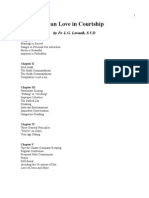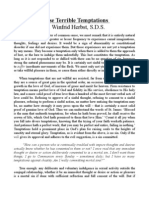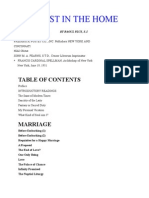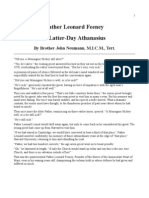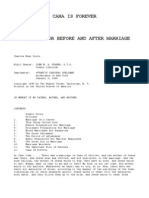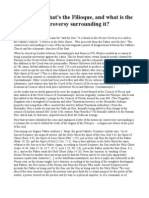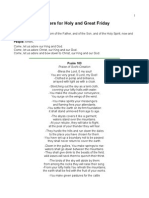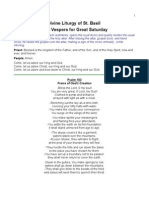Professional Documents
Culture Documents
The Penecostal Movement: A Threat To The Faith
Uploaded by
ExtraEcclesiamNullaSalus100%(1)100% found this document useful (1 vote)
899 views24 pagesThe Catholic Charismatic movement is a threat to the faith. Here is a booklet that explains why.
Original Title
The Penecostal Movement: A Threat to the Faith
Copyright
© Attribution Non-Commercial (BY-NC)
Available Formats
PDF or read online from Scribd
Share this document
Did you find this document useful?
Is this content inappropriate?
Report this DocumentThe Catholic Charismatic movement is a threat to the faith. Here is a booklet that explains why.
Copyright:
Attribution Non-Commercial (BY-NC)
Available Formats
Download as PDF or read online from Scribd
100%(1)100% found this document useful (1 vote)
899 views24 pagesThe Penecostal Movement: A Threat To The Faith
Uploaded by
ExtraEcclesiamNullaSalusThe Catholic Charismatic movement is a threat to the faith. Here is a booklet that explains why.
Copyright:
Attribution Non-Commercial (BY-NC)
Available Formats
Download as PDF or read online from Scribd
You are on page 1of 24
The Pentecostal Movement
A THREAT TO THE FAITH
R. Saverino
CO” NSD
Come Holy Ghost
fill all hearts!
The Pentecostal
Movement
A Threat to the Faith
Prontecostaiia is a new heresy
which has infiltrated the Church in
order to destroy it from within. It is
the companion and supporter of
Modernism. The two movements
go hand in hand and assist each
other in the work of demolition.
Modernism is undermining the
Church at the level of doctrine.
Pentecostalism at the level of wor-
ship. Both are well covered with
the sheep’s skin. They have
enough of Catholic terminology;
pious phrases and external de-
meanor to deceive even most cau-
tious people. It is therefore neces-
Sary to tear the skin off their bodies
in order to expose the ravenous
wolves within. Pentecostalism is a
subversive movement, controlled
and adroitly guided by hidden ene-
mies of the Church in order to un-
dermine it in view of its total de-
struction.
ITS CLAIMS
Pentecostalism promises its adher-
ents the same plenitude and expe-
rience of the Holy Spirit which the
Apostles had on Pentecost Day,
along with at least some of the ex-
ternal gifts they then received,
principal among them, the gifts of
tongues, healing and prophesy.
This extraordinary experience is
brought about by the “Baptism of
the Spirit”, which they claim
through the imposition of hands.
The adjectives “Pentecostal” and
“Charismatic” perfectly describe its
claims. “Pentecostal” refers to the
plenitude of the Holy Spirit received
on the first Pentecost sunday
while “Charismatic” refers to
charisms or extraordinary sup,
natural gifts which accompanied
the reception of the Holy Spirit on
that day.
Many people are deceived here.
They think the movement wants
merely to offer special prayers and
intensify devotion to the Third Per-
son of the Blessed Trinity. It is not
so. Its claims are much greater and |
its effects, if true, by far surpass
any of the effects produced by the
other seven Sacraments institu
by Christ.
The contention here is that the
Charismatic Movement and the
Catholic Church cannot go to-
gether. if the Church is true, then
Pentecostalism is false, and vice
versa, if Pentecostalism is true, the
Catholic Church is false. But since
the One, Holy, Catholic, Apostolic”
and Roman Church cannot be false,
it follows that Pentecostalism is
false and must be rejected. {
W. shall look at the movement
from various angles. In so doing it
will not be possible to avoid a cer-
tain amount of repetition, which
however will help the reader to form
as complete a picture as possible
of a movement which touches the
very roots of Christian piety.
1. BASED ON SHIFTING SANDS
Doctrinally the movement is based
on shifting sands. Anyone, in fact,
who would attempt to analyze it in
the light of the infallible teaching of
the Church and its authentic tradi.
tion is faced with something that
eludes his grasp. The Movement
claims to be based on personal
J
experience and direct inspiration of
the Holy Spirit, two things which no
one can check. It is, they say, bub-
bling with life that it is incapable of
being defined and circumscribed
within the boundaries of set doc-
trinal formulas. As a result, the
Charismatic Movement has no firm
body of doctrine, but only elusive
affirmations, flimsy references to
the New Testament, tentative and
provisional formulations. It is an
evanescent shadow!
a leaders themselves admit
this: “Theological and Pastoral
Orientations on the Catholic Char-
ismatic Renewal” is one of the most
important documents of the Move-
ment. It was prepared at Malines
(Belgium), May 21-26, 1974, by a
few international “experts” under
the guidance of Cardinal Leo Sue-
nens of Malines, who, the docu-
ment informs us, “took an active
part in the discussion and formula-
tion of the text”. (Preface v). We
are told that the document “is not
exhaustive and that further studies
are required. The present state-
ment represents one of the main
streams of thought. The text is of-
fered as a tentative answer to the
main problems raised by the Char-
ismatic Renewal.” (Pref. V). In
other words, the authors do not
know what they are about, “the
blind leading the blind”!
When we turn to the text itself, we
meet with a mass of elusive state-
ments and semi-statements, tenta-
tive answers and opinions. Hardly
any distinctions are ever made. Yet
distinctions are the very web and
fabric of any theological argument.
Without them it is impossible to sift
truth from falsehood, opinion or
hypothesis from firm doctrine.
Take for instance this passage on
page 21 entitled, Religious Experi-
ence Belongs to the New Testament
Witness — “The experience of The
Holy Spirit was a mark of a Chris-
tian by which the early Christians in
part defined themselves in relation
to others who were not Christians.
They thought of themselves as rep-
resentatives not of a new teaching,
but of a new reality, the Holy Spirit.
This Spirit was a living, experi-
enced fact which they could not
deny without denying that they
were Christians. The Spirit was
poured out on them and was expe-
rienced by them individually and
communally as a oo reality. Re-
ligious experience, " it must be ad-
mitted, belongs to the New Testa-
ment witness; if one simply re-
moved from the life of the Church
its dimension, one has to that de-
gree impoverished the Church”.
It would be difficult to compress
within one paragraph so much
truth, untruth and half-truth. The
reading is smooth, it sounds pious,
and, to the unwary, also convinc-
ing, but it is actually false!
It is false to say that “the early
Christians thought of themselves
as representatives not of a new
teaching, but of a new reality, the
Holy Spirit”. The fact is that Christ
ordered the Apostles to go and
teach all nations. Now to teach is
first, foremost and above all, to ac-
cept and impart a body of doctrine,
not to “experience” it, a thing which
is very subjective and therefore
very much liable to self-deception.
“The Experience and Faith Thesis”
is the thesis of Luther, not of
Christ, who came to “give witness
to the Truth and taught us a very
definite body of doctrine with re-
gard to the Father, Himself, the
Holy Spirit, His Church, the Sacra-
ments, etc. He exacted that his
teaching should be accepted with
blind faith and not “experienced”.
“He who believes and is baptized
will be saved; he who does not be-
lieve will be condemned”. (Mk.
16:16.) St. Paul wrote some very
hard things to the Galatians be-
cause, they had lapsed from his
first teaching and told them that
even if he himself or an angel were
to preach to them a doctrine differ-
ent from what he had preached to
them at the beginning, he should be
considered anathema. The Apos-
tles and the first Christians were
very much concerned with doctrine,
and very little with feeling and ex-
perience.
Ts rest of the paragraph, and
indeed the whole chapter dealing
with “Faith and Experience”, is a
masterpiece of confusion. Take
this, for instance, “The Spirit was
poured out on them and was expe-
rienced by them individually and
communally as a new reality”. This
would imply, but the authors are
very careful not to expose them-
selves with a categorical statement,
that all the Christians of the Apos-
tolic Age received the effusion of
the Holy Spirit and experienced Him
in the same way and with the same
mystical and miraculous phenom-
ena of the Apostles on Pentecost
Day. But this is false. There is
nothing in the New Testament, in
the writings of the Fathers, or any-
where in the official teaching of the
Church, that this was the case. The
New Testament indeed mentions
‘some cases when the Holy Spirit
did come down in a marvelous
manner on the new Christians, but
these were few and isolated cases.
Even on the very first day, when
3000 people were baptized and be-
came the Church’s first converts,
there is no mention of any miracu-
lous manifestation of the Holy Spirit
in them.
aR. the words quoted above
‘mix up two different things, on
the one the intimate peace and joy
which is the happy fortune of every
true Christian, peace and joy which
surpasses every sense and human
understanding and which no one
can take away from him; and on the
other, the extraordinary mystical
experience and some other wonder-
ful charisms granted to the Apos-
tles on Pentecost Day —and to cer-
tain privileged souls down the cen-
turies God does occasionally be-
stow such divine things to the chil-
dren of men, but they are in no way
due to man, they have not been
promised to every Christian and
they are not necessary for one’s
sanctification.
2. FORERUNNERS OF
PENTECOSTALISM
Today the Church is being riddled
with what people think to be “new”
insights and “new” doctrines. Ac-
tually they are not new, but merely
old errors dressed in new clothes,
new only to those people, and they
are legion, who have forgotten or
have never known what the past
was like. The inspired Wise Man
affirms that “There is nothing new
under the sun". No, not even Pen-
tecostalism!
It would be interesting to trace the
origin, development and character
of heresies, but that would take us
too far. However, there is one thing
common to them all. Their found.
ers gnd their followers claimed
You might also like
- The Subtle Art of Not Giving a F*ck: A Counterintuitive Approach to Living a Good LifeFrom EverandThe Subtle Art of Not Giving a F*ck: A Counterintuitive Approach to Living a Good LifeRating: 4 out of 5 stars4/5 (5794)
- The Gifts of Imperfection: Let Go of Who You Think You're Supposed to Be and Embrace Who You AreFrom EverandThe Gifts of Imperfection: Let Go of Who You Think You're Supposed to Be and Embrace Who You AreRating: 4 out of 5 stars4/5 (1090)
- Never Split the Difference: Negotiating As If Your Life Depended On ItFrom EverandNever Split the Difference: Negotiating As If Your Life Depended On ItRating: 4.5 out of 5 stars4.5/5 (838)
- Hidden Figures: The American Dream and the Untold Story of the Black Women Mathematicians Who Helped Win the Space RaceFrom EverandHidden Figures: The American Dream and the Untold Story of the Black Women Mathematicians Who Helped Win the Space RaceRating: 4 out of 5 stars4/5 (890)
- Grit: The Power of Passion and PerseveranceFrom EverandGrit: The Power of Passion and PerseveranceRating: 4 out of 5 stars4/5 (587)
- Shoe Dog: A Memoir by the Creator of NikeFrom EverandShoe Dog: A Memoir by the Creator of NikeRating: 4.5 out of 5 stars4.5/5 (537)
- Elon Musk: Tesla, SpaceX, and the Quest for a Fantastic FutureFrom EverandElon Musk: Tesla, SpaceX, and the Quest for a Fantastic FutureRating: 4.5 out of 5 stars4.5/5 (474)
- The Hard Thing About Hard Things: Building a Business When There Are No Easy AnswersFrom EverandThe Hard Thing About Hard Things: Building a Business When There Are No Easy AnswersRating: 4.5 out of 5 stars4.5/5 (344)
- Her Body and Other Parties: StoriesFrom EverandHer Body and Other Parties: StoriesRating: 4 out of 5 stars4/5 (821)
- The Sympathizer: A Novel (Pulitzer Prize for Fiction)From EverandThe Sympathizer: A Novel (Pulitzer Prize for Fiction)Rating: 4.5 out of 5 stars4.5/5 (119)
- The Emperor of All Maladies: A Biography of CancerFrom EverandThe Emperor of All Maladies: A Biography of CancerRating: 4.5 out of 5 stars4.5/5 (271)
- The Little Book of Hygge: Danish Secrets to Happy LivingFrom EverandThe Little Book of Hygge: Danish Secrets to Happy LivingRating: 3.5 out of 5 stars3.5/5 (399)
- The World Is Flat 3.0: A Brief History of the Twenty-first CenturyFrom EverandThe World Is Flat 3.0: A Brief History of the Twenty-first CenturyRating: 3.5 out of 5 stars3.5/5 (2219)
- The Yellow House: A Memoir (2019 National Book Award Winner)From EverandThe Yellow House: A Memoir (2019 National Book Award Winner)Rating: 4 out of 5 stars4/5 (98)
- Devil in the Grove: Thurgood Marshall, the Groveland Boys, and the Dawn of a New AmericaFrom EverandDevil in the Grove: Thurgood Marshall, the Groveland Boys, and the Dawn of a New AmericaRating: 4.5 out of 5 stars4.5/5 (265)
- A Heartbreaking Work Of Staggering Genius: A Memoir Based on a True StoryFrom EverandA Heartbreaking Work Of Staggering Genius: A Memoir Based on a True StoryRating: 3.5 out of 5 stars3.5/5 (231)
- Team of Rivals: The Political Genius of Abraham LincolnFrom EverandTeam of Rivals: The Political Genius of Abraham LincolnRating: 4.5 out of 5 stars4.5/5 (234)
- Clean Love in Courtship by Fr. L.G. Lovasik, S.V.DDocument34 pagesClean Love in Courtship by Fr. L.G. Lovasik, S.V.DExtraEcclesiamNullaSalus100% (5)
- On Fire: The (Burning) Case for a Green New DealFrom EverandOn Fire: The (Burning) Case for a Green New DealRating: 4 out of 5 stars4/5 (73)
- The Unwinding: An Inner History of the New AmericaFrom EverandThe Unwinding: An Inner History of the New AmericaRating: 4 out of 5 stars4/5 (45)
- Those Terrible Temptations by Fr. Winfrid Herbst, S.D.S.Document6 pagesThose Terrible Temptations by Fr. Winfrid Herbst, S.D.S.ExtraEcclesiamNullaSalus100% (1)
- Christ in The Home by Raoul Plus, S.J.Document162 pagesChrist in The Home by Raoul Plus, S.J.ExtraEcclesiamNullaSalus100% (3)
- Fr. Leonard Feeney - A Modern-Day AthanasiusDocument31 pagesFr. Leonard Feeney - A Modern-Day AthanasiusExtraEcclesiamNullaSalusNo ratings yet
- Authoritative Catholic Teaching Regarding Dating and Courtship Issues: KissingDocument1 pageAuthoritative Catholic Teaching Regarding Dating and Courtship Issues: KissingExtraEcclesiamNullaSalusNo ratings yet
- "Further Observations On The Question of Salvation Outside The Church" by Brother Thomas Mary Sennott, MICMDocument16 pages"Further Observations On The Question of Salvation Outside The Church" by Brother Thomas Mary Sennott, MICMExtraEcclesiamNullaSalus100% (1)
- "Behold Thy Mother" Immaculate Heart Revelations by Rev. James M. Keane, O.S.M. (November 4, 1954 Vol. 3 No. 18)Document8 pages"Behold Thy Mother" Immaculate Heart Revelations by Rev. James M. Keane, O.S.M. (November 4, 1954 Vol. 3 No. 18)ExtraEcclesiamNullaSalus100% (2)
- Doctors of The Church On "Extra Ecclesiam Nulla Salus"Document1 pageDoctors of The Church On "Extra Ecclesiam Nulla Salus"ExtraEcclesiamNullaSalusNo ratings yet
- The Reign of Christ The King by Michael DaviesDocument16 pagesThe Reign of Christ The King by Michael DaviesExtraEcclesiamNullaSalus100% (1)
- The Practice of Perfection and Christian Virtues Vol. #3 by Fr. Alphonsus Rodriguez, S.J.Document161 pagesThe Practice of Perfection and Christian Virtues Vol. #3 by Fr. Alphonsus Rodriguez, S.J.ExtraEcclesiamNullaSalusNo ratings yet
- Cana Is Forever: Counsels For Before and After Marriage by Fr. Charles Hugo DoyleDocument135 pagesCana Is Forever: Counsels For Before and After Marriage by Fr. Charles Hugo DoyleExtraEcclesiamNullaSalus100% (1)
- The Practice of Perfection and Christian Virtues Vol. #1 by Fr. Alphonsus Rodriguez, S.J.Document196 pagesThe Practice of Perfection and Christian Virtues Vol. #1 by Fr. Alphonsus Rodriguez, S.J.ExtraEcclesiamNullaSalus100% (4)
- St. Vincent Ferrer - Sermon On PurgatoryDocument4 pagesSt. Vincent Ferrer - Sermon On PurgatoryExtraEcclesiamNullaSalus100% (2)
- The Practice of Perfection and Christian Virtues Vol. #2 by Fr. Alphonsus Rodriguez, S.J.Document245 pagesThe Practice of Perfection and Christian Virtues Vol. #2 by Fr. Alphonsus Rodriguez, S.J.ExtraEcclesiamNullaSalus100% (1)
- The Christian Home: A Guide To Happiness in The Home by Celestine Strub, O.F.M.Document52 pagesThe Christian Home: A Guide To Happiness in The Home by Celestine Strub, O.F.M.ExtraEcclesiamNullaSalus100% (1)
- What Rule of Life Should You Have?Document4 pagesWhat Rule of Life Should You Have?ExtraEcclesiamNullaSalus100% (3)
- Examination of Conscience For Adults - Based On Twelve Virtues For The Twelve Months of The YearDocument47 pagesExamination of Conscience For Adults - Based On Twelve Virtues For The Twelve Months of The YearExtraEcclesiamNullaSalus100% (2)
- Dining Room Etiquette and How To Serve A MealDocument8 pagesDining Room Etiquette and How To Serve A MealExtraEcclesiamNullaSalusNo ratings yet
- Writings of Rev. Arnold Damen, S.J.Document24 pagesWritings of Rev. Arnold Damen, S.J.ExtraEcclesiamNullaSalusNo ratings yet
- Clarification On The Doctrines of Baptism of Desire and Blood From The Still River, MA Saint Benedict CenterDocument1 pageClarification On The Doctrines of Baptism of Desire and Blood From The Still River, MA Saint Benedict CenterExtraEcclesiamNullaSalusNo ratings yet
- The History of The Saint Benedict Center and The Slaves of The Immaculate Heart of MaryDocument17 pagesThe History of The Saint Benedict Center and The Slaves of The Immaculate Heart of MaryExtraEcclesiamNullaSalusNo ratings yet
- Catholic Answers' Apologist James Akin Refuted by Adam Miller of Tower of David MinistryDocument27 pagesCatholic Answers' Apologist James Akin Refuted by Adam Miller of Tower of David MinistryExtraEcclesiamNullaSalusNo ratings yet
- Architects of Confusion: The Unmasking of The Plot Against The Church's Foundational Doctrine On SalvationDocument23 pagesArchitects of Confusion: The Unmasking of The Plot Against The Church's Foundational Doctrine On SalvationExtraEcclesiamNullaSalusNo ratings yet
- What's The Filioque, and What Is The Controversy Surrounding It?Document2 pagesWhat's The Filioque, and What Is The Controversy Surrounding It?ExtraEcclesiamNullaSalusNo ratings yet
- "Philosophia Perennis" by Brother Francis Maluf, M.I.C.M.Document119 pages"Philosophia Perennis" by Brother Francis Maluf, M.I.C.M.ExtraEcclesiamNullaSalus100% (4)
- The Miracle of Fatima, El Milagro de Fatima, O Milagre de FatimaDocument3 pagesThe Miracle of Fatima, El Milagro de Fatima, O Milagre de FatimaExtraEcclesiamNullaSalusNo ratings yet
- "Is Laisneyism Catholic?" A Refutation of The Errors of Fr. Francois Laisney, SSPXDocument6 pages"Is Laisneyism Catholic?" A Refutation of The Errors of Fr. Francois Laisney, SSPXExtraEcclesiamNullaSalusNo ratings yet
- Vespers For Holy and Great FridayDocument13 pagesVespers For Holy and Great FridayExtraEcclesiamNullaSalusNo ratings yet
- Divine Liturgy of St. Basil With Vespers For Great SaturdayDocument20 pagesDivine Liturgy of St. Basil With Vespers For Great SaturdayExtraEcclesiamNullaSalusNo ratings yet


































